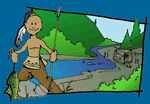


Geography and Landforms:
Florida is made up of three geographic land areas: The Atlantic Coastal Plain, the East Gulf Coastal Plain and the Florida Uplands. The Atlantic Coastal Plain covers the eastern part of Florida, and is low and level. This area includes the Big Cypress Swamp, the Everglades, and the island chain known as the Florida keys. The East Gulf Coastal Plain encompasses the coastal areas that border the Gulf of Mexico, and also includes parts of the Big Cypress Swamp and the Everglades, as well as the barrier islands along the west coast of the peninsula. The Florida Uplands run along the northern edge of the Florida Planhandle, and includes parts of the central area of the peninsula. This area is characterized by low rolling hills of red clay. There are both hard and softwood forests. This area also includes Florida's highest point, Britton Hill, which is only 345 feet above sea level and the lowest state high point in the nation.
|
 History:
The first European explorer to come to Florida was Spaniard Juan Ponce de Leon in 1513. He first came ashore on the northeast coast of Florida near present-day St. Augustine. He called the area la Florida after Spain's Eastertime celebration Pascua Florida ("feast of the flowers").
|
 Economy:
After the years of "reconstruction" following the Civil War, Florida's economy was influenced by large scale commercial agriculture. The citrus fruit industry grew, and other enterprises focused on Florida's rich natural resources became important. These included such resources as natural sponges, and the mining of phosphates. Beginning in the 1870s, people from the northern part of the United States began to travel to Florida to enjoy the climate, and tourism became more central to the state's economy.
|
 First Inhabitants:
The first people to live in Florida probably arrived at least 12,000 years ago. Florida's environment and climate meant the area was rich with plants and wildlife and included most of the mammals that live there today. In addition, Florida was home to other large animals that are now extinct including the saber-tooth tiger, the mastodon, and the giant armadillo. Because the sea level was much lower 12,000 years ago, the Florida peninsula was more than twice the size it is today. The people who lived in this area were hunters and gatherers who lived on small animals, plants, nuts, and shellfish. They settled in areas that had a steady water supply, ample stone for making tools, and sufficient firewood.
|
Books Related To FloridaA Couple of Boys Have the Best Week Ever - Marla Frazee Because of Winn-Dixie - Kate DiCamillo Copper Sun - Sharon Draper Everglades - Jean Craighead George The Great Pig Search - Eileen Christelow How Many Days to America: A Thanksgiving Story - Eve Bunting La Noche Buena: A Christmas Story - Antonio Sacre S is for Sunshine: A Florida Alphabet - Carol Crane The Secret River - Marjorie Kinnan Rawlings Strawberry Girl - Lois Lenski The Yearling - Marjorie Kinnan Rawlings |
Famous Citizens:
|
| Capital: | Tallahassee |
| Entered Union: | March 3, 1845 |
| Population: | 19,893,297 |
| Area | 65,755 |
| Bird | Mockingbird |
| Flower | Orange Blossom |
| Nickname: | Sunshine State |
| Governor | Rick Scott |
Places to Visit in Florida: (Click the links to learn more.)
|



